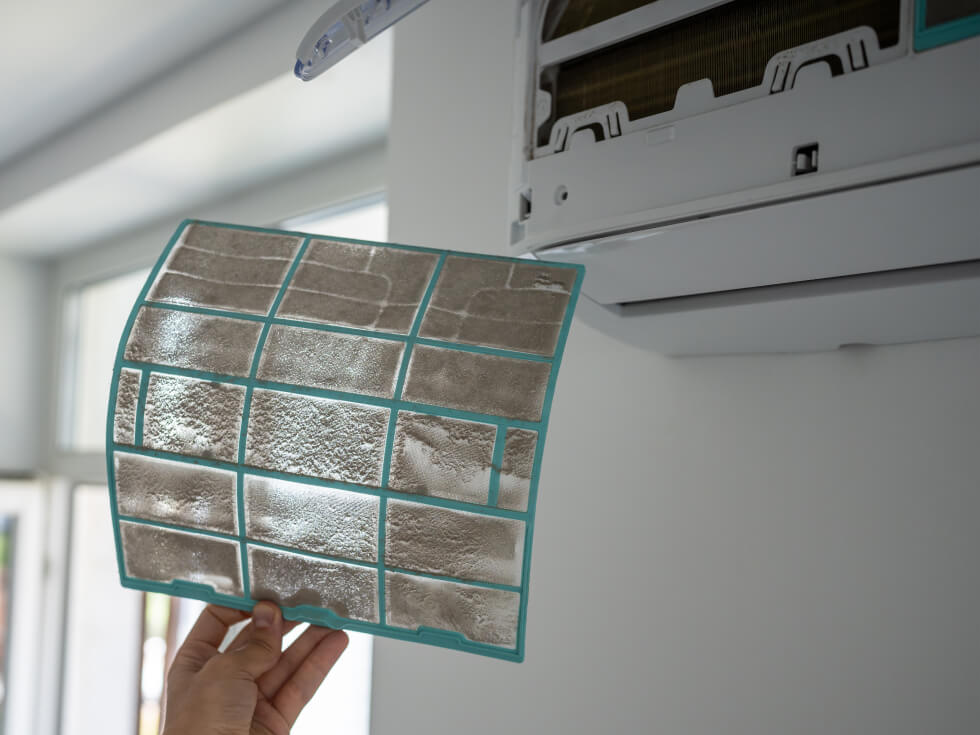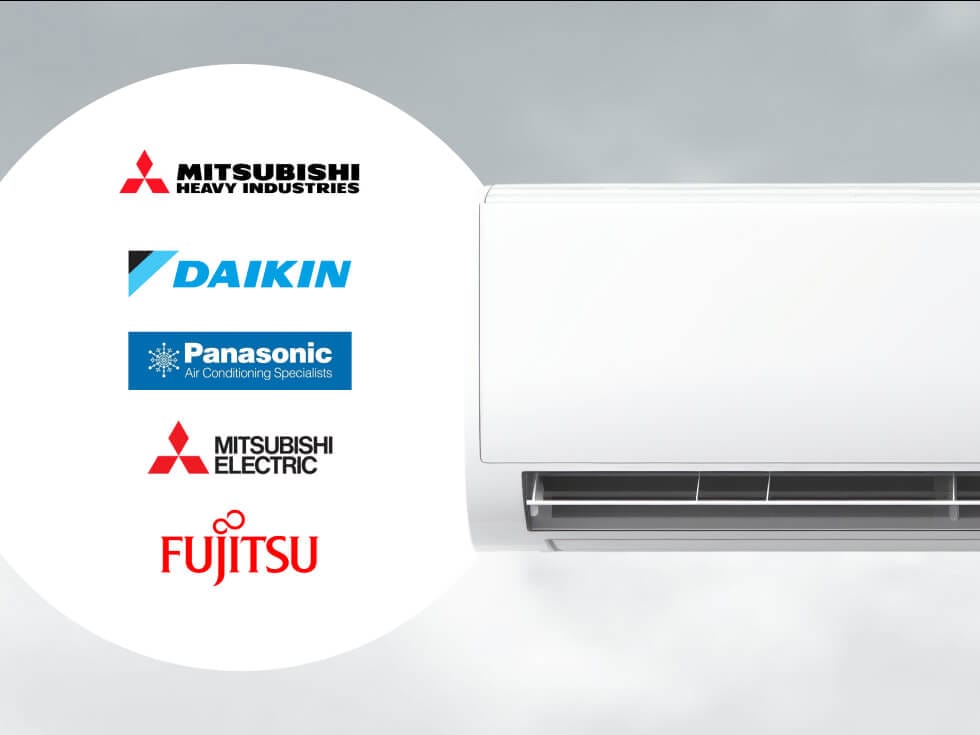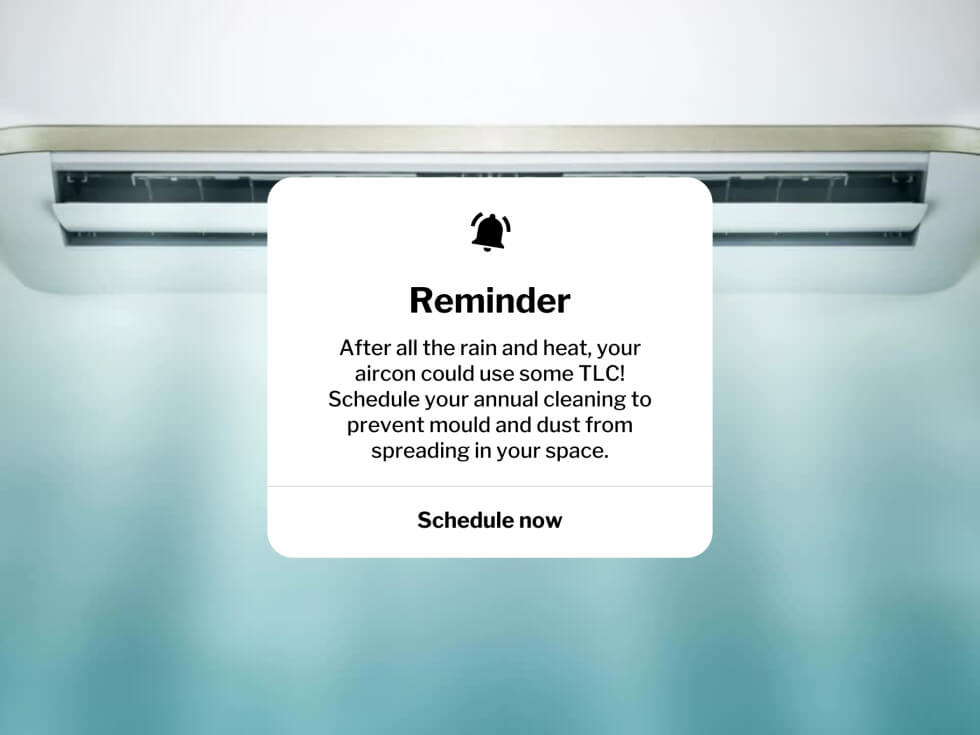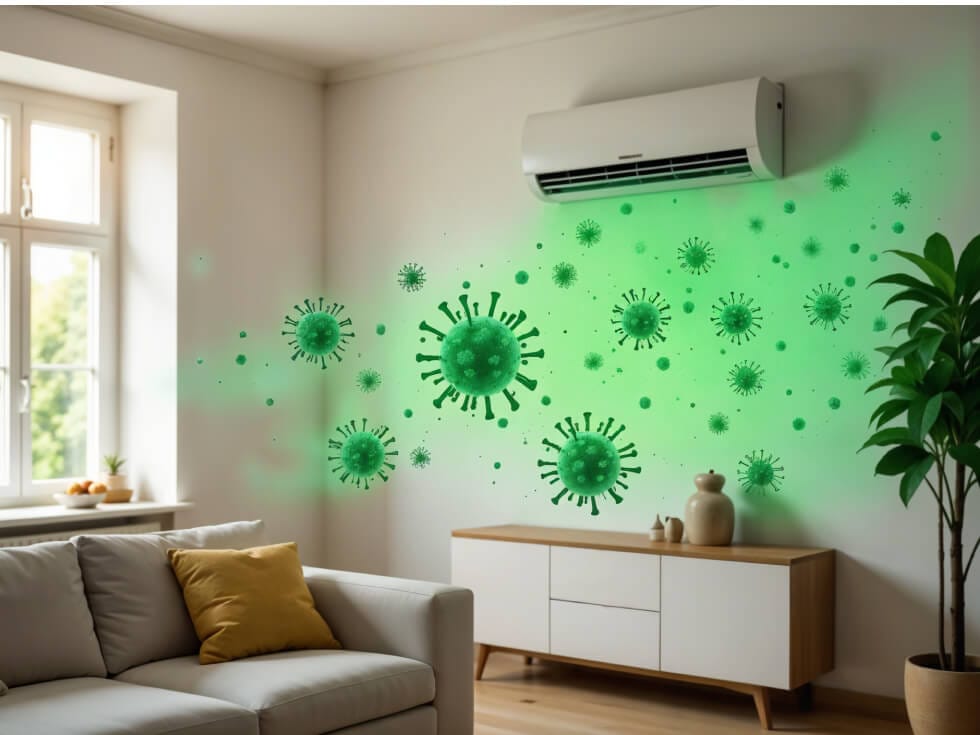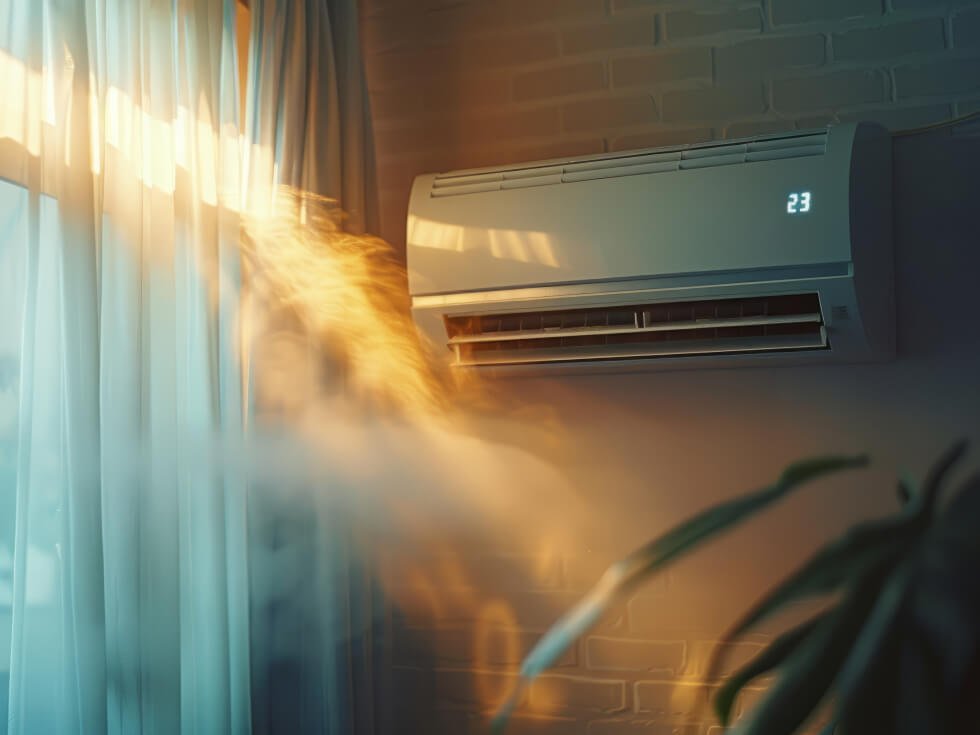Did you know that nearly 50% of homes with air conditioners have experienced mould growth within these units at some point? This statistic highlights a significant yet often overlooked issue – the health dangers and efficiency problems posed by mould in air conditioners. When it comes to air conditioner mould removal and implementing strategies to prevent mould in your aircon, this article got you covered.
Tackling mould in air conditioner systems is essential for maintaining good air quality and health. While routine cleaning can often manage minor mould issues, more significant infestations may require professional intervention. Overall, proper maintenance not only keeps the unit in good working condition but also reduces the health risks associated with air conditioning mould.
Key Takeaways
- Almost half of homes encounter mould growth in their air conditioners, underscoring its prevalence and risk.
- Mould in air conditioners poses serious health threats and impacts system efficiency.
- Professional services can help with air conditioner mould removal and ongoing maintenance.
- Regular professional maintenance and cleaning ensures the elimination of harmful mould spores from your aircon unit.
- Preventing mould in your air conditioner is essential to safeguard indoor air quality.
The Risks of Mould in Air Conditioners
The presence of mould in air conditioners is more than just a nuisance; it’s a significant health concern. As these mould spores disperse through the indoor environment, they’re inhaled by occupants, leading to various health problems.
Health Hazards
One of the primary health risks of mould in air conditioners is the effect on indoor air quality. Poor indoor air quality can lead to immediate issues such as headaches, dizziness, and fatigue. Long-term exposure, however, is far more dangerous. Prolonged exposure to mould spores can result in severe mould-related health concerns, including chronic respiratory problems, skin irritation, and even pulmonary infections.
Respiratory Issues
In particular, respiratory issues are a major concern. The moisture-laden environment of air conditioners in humid climates creates ideal conditions for mould growth. When these spores become airborne, they can exacerbate asthma, cause allergic reactions, and lead to severe conditions like pneumonia. Children, the elderly, and individuals with compromised immune systems are especially vulnerable to these risks.
The health risks of mould in air conditioners highlights the importance of maintaining good indoor air quality. Addressing mould-related health concerns promptly ensures that air conditioner health remains optimal and protects the well-being of all household members.
Signs of Mould in Air Conditioners
Be vigilant when it comes to detecting potential mould growth within your air conditioning system. Early identification can prevent serious health issues and damage to your property.
Musty Odour
One of the initial signs of mould in air conditioners is a distinct musty odour emanating from the unit when it’s running. This smell is often caused by mould spores circulating through the air, making it a clear indicator that identifying mould growth is necessary.
Visible Mould Spots
Another tell-tale sign of mould in air conditioners is the appearance of visible mould in HVAC components. These spots often manifest as black or grey circular marks, which can be found on the air conditioner surfaces, vents, or even on nearby walls and ceilings. Prompt investigation of these signs is crucial to address the issue before mould spreads throughout your property.
- Check for musty odour in air conditioning systems regularly.
- Inspect the unit and surrounding areas for visible mould spots.
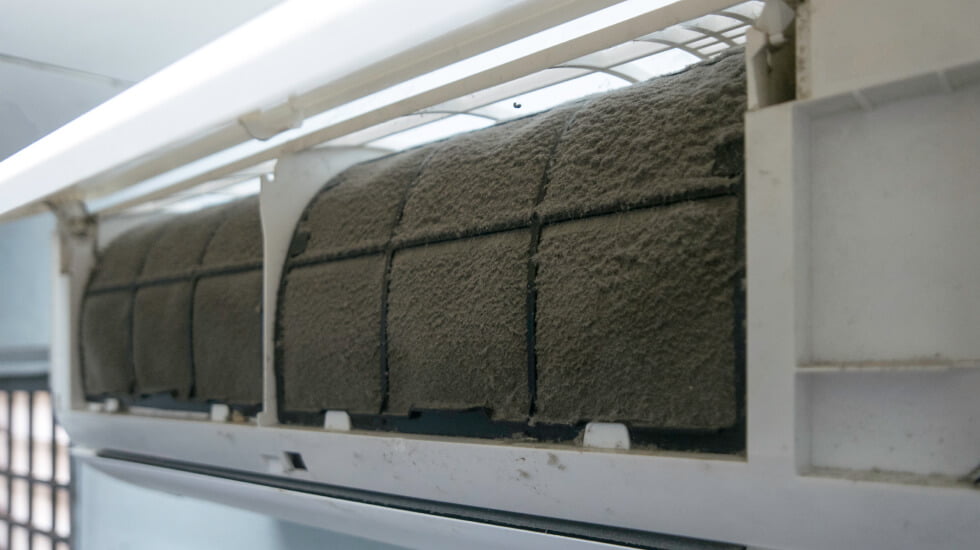
How Mould Grows in Air Conditioners
Mould growth in air conditioners is primarily driven by three factors: moisture build-up, dust and debris, and temperature variations.
Moisture Build-Up
Air conditioners inherently produce moisture as a byproduct of the cooling process, leading to condensation build-up. This moisture creates an ideal breeding ground for mould. Proper maintenance is necessary to mitigate moisture and mould accumulation within the unit.
Dust and Debris
Dust and debris serve as a nutrient source for mould spores. Regularly combating dust and debris by cleaning or replacing filters helps prevent mould proliferation. Keeping air conditioners free from dust not only curtails mould growth but also improves air quality.
Temperature Variations
Temperature control in HVAC systems is essential to prevent mould growth. Fluctuating temperatures can aggravate moisture problems, creating a conducive environment for mould. Consistent temperature control helps maintain an inhospitable climate for mould in air conditioners.
| Factor | Impact | Prevention |
|---|---|---|
| Moisture Build-Up | Facilitates mould growth | Regular cleaning and servicing |
| Dust and Debris | Provides food for mould | Frequent filter checks and replacements |
| Temperature Variations | Creates favourable conditions | Consistent temperature control |
Inspection and Identification of Mould Presence
A careful and thorough evaluation of air conditioners is vital to uncover any mould infestations that might be lurking within. By addressing both the visible and hidden areas of the unit, we can effectively pinpoint and manage any mould issues that arise.
Checking Air Conditioning Ducts
Performing comprehensive air conditioner duct checks is also essential. Ducts can often harbour mould spores, especially if they have accumulated dust and moisture. Visual inspections, coupled with regular maintenance, can help in early detection and management of mould infestation.
Professional Spore Count Testing
For a more detailed assessment, engaging in spore count testing in HVAC systems is recommended. This method provides an accurate measure of mould presence by auditing airborne spores. Professional spore count testing dives into the specifics of mould types and concentrations, offering a scientific basis to assess the extent of contamination and plan for effective remediation.
Effective Methods for Mould Removal
Approaching mould removal requires careful consideration of various methods, including DIY solutions and commercial cleaners, each with its distinct advantages.
DIY Cleaning Solutions
For homeowners inclined towards a do-it-yourself approach, several mould removal techniques can be effective. DIY mould removal often involves using natural remedies such as tea tree oil, vinegar, and methylated spirits, known for their anti-mould properties. It’s essential to wear protective gear like gloves and masks to safeguard against mould spores and harmful chemicals during the cleaning process. Make sure to thoroughly wipe down all affected areas, ensuring that the moisture source is addressed to prevent mould from returning.
Using Commercial Cleaners
Commercial cleaners for air conditioners are specifically formulated for effective mould removal within HVAC systems. These products often provide a long-lasting solution, sometimes preventing mould reoccurrence for up to 12 months. Commercial cleaners typically offer a more comprehensive treatment compared to DIY methods, as they are designed to penetrate deeper into air conditioner components. However, it’s crucial to follow the manufacturer’s instructions meticulously to avoid damaging the unit or impacting indoor air quality adversely.
| Method | Advantages | Disadvantages |
|---|---|---|
| DIY Cleaning Solutions | Cost-effective, Uses natural ingredients, Can be done immediately | Less powerful, Requires protective gear, May need more frequent applications |
| Commercial Cleaners | Highly effective, Long-lasting, Designed for air conditioners | More expensive, Requires careful handling, Potential chemical exposure |
Preventive Measures for Mould Growth
Preventing mould growth in air conditioners requires consistent attention and routine maintenance. By adopting several preventive strategies, we can significantly reduce the likelihood of mould becoming an issue in our HVAC systems.
Regular Cleaning Schedules
Mould prevention starts with regular cleaning schedules. Consistently cleaning every component of the air conditioner ensures there are no dirt or organic particles that serve as food sources for mould. It’s vital to clean the cooling coils, drain pans, and other key areas where moisture can accumulate.
Maintaining Filter Integrity
One of the simplest yet most effective measures for mould prevention is maintaining the integrity of our air conditioner filters. Clean and properly fitted filters not only improve air quality but also prevent mould growth by reducing the amount of dust and debris in the system. Therefore, regularly replacing or cleaning filters as per manufacturer recommendations is essential.
Preventing Moisture Accumulation
Addressing the issue of moisture is crucial in HVAC maintenance. Regularly servicing condensation trays and ensuring there is no standing water in the unit helps in preventing moisture in air conditioners, which is a common cause of mould growth. It is also beneficial to keep an eye on humidity levels within the indoor environment to further mitigate the risks.
Here is a comparative table highlighting key preventive measures for mould growth in air conditioners:
| Preventive Measure | Action Required | Frequency |
|---|---|---|
| Regular Cleaning | Clean coils, drain pans, and other moisture-prone areas | Monthly |
| Filter Maintenance | Replace or clean filters | Every 3-6 months |
| Moisture Control | Service condensation trays, eliminate standing water | Annually or as needed |
Professional Mould Inspection and Removal
When it comes to maintaining a healthy and efficient HVAC system, sometimes professional intervention is necessary. Let’s delve into the scenarios that warrant a professional mould inspection and the meticulous steps professionals take for expert mould removal.
When to Call a Professional
Recognising the moment to seek professional mould inspection is crucial for the longevity and safety of your HVAC system. If you notice persistent musty odours, visible mould growth, or experience unexplained allergic reactions, it’s time to call in the experts. HVAC specialist services ensure a comprehensive assessment, addressing areas that are often difficult to inspect and clean.
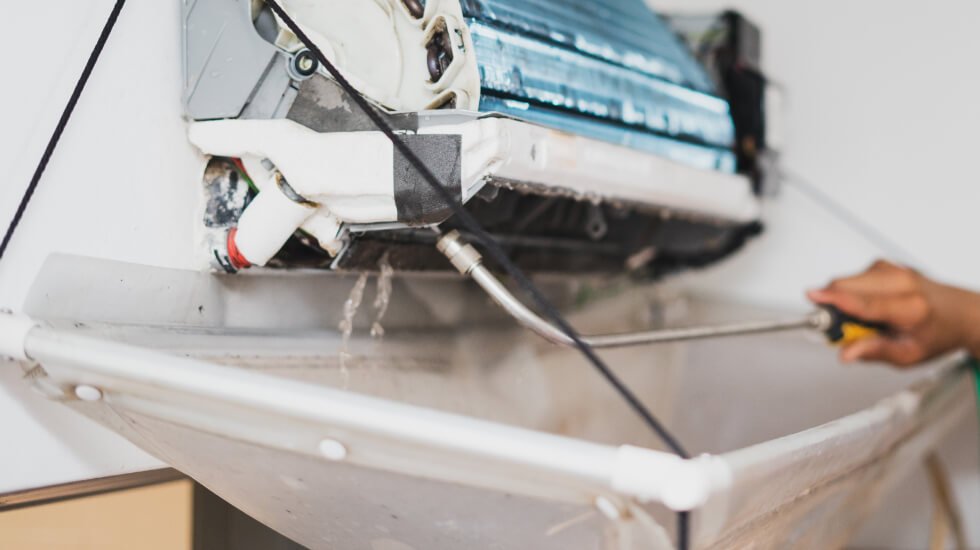
Steps Professionals Take
The process of expert mould removal involves several key steps:
- Initial Assessment: Professionals conduct a thorough inspection to identify all mould-affected areas.
- Containment: To prevent spores from spreading, affected zones are carefully sealed off.
- Cleaning and Removal: Using specialised equipment, mould is meticulously cleaned from all surfaces.
- Filter Replacement: HVAC filters are replaced to ensure no spores remain trapped within the system.
- Final Inspection: A final check ensures all mould has been effectively removed and preventive measures are in place.
By engaging professional mould inspection and expert mould removal services, we can ensure our HVAC systems remain clean, efficient, and safe for our homes and workplaces.
The Role of Air Conditioner Maintenance in Preventing Mould
One key aspect of this upkeep is air conditioner cleaning, which involves not only cleaning the filters but also ensuring other components are free from dust and debris. This reduces the risk of mould, as cleanliness inhibits its establishment within the unit.
Filters, if unattended, can become breeding grounds for mould, which is why clean or replaced filters are paramount. Consistent cleaning helps maintain optimal indoor air quality and extends the life of the unit.
An often-overlooked aspect of HVAC system upkeep involves ensuring the unit is operational, even at higher temperatures, during extended periods of non-use. Running the air conditioner occasionally helps prevent the internal environment from becoming conducive to mould growth, thus reducing the likelihood of mould issues when the unit is back in regular use.
Investing in regular air conditioner cleaning and maintenance not only protects your health but also enhances the efficiency and longevity of your air conditioning system, saving you money on repairs. These proactive measures collectively contribute to a healthier indoor environment and a reliable HVAC system.
Products and Tools for Mould Prevention
Investing in effective mould prevention products and tools is crucial for maintaining a healthy and efficient air conditioning system. By using specific anti-mould sprays and exploring advanced mould-inhibiting technologies, we can significantly reduce the risk of mould growth in our HVAC systems.
Anti-Mould Sprays
Anti-mould sprays are specially formulated solutions designed to create a protective barrier against mould formation. These solutions are straightforward to apply and can be used to treat various components of our air conditioners, including filters and ducts. Regular use of these sprays helps ensure that mould spores do not settle or thrive in our air conditioning units, making them a practical and accessible option for homeowners and businesses alike.
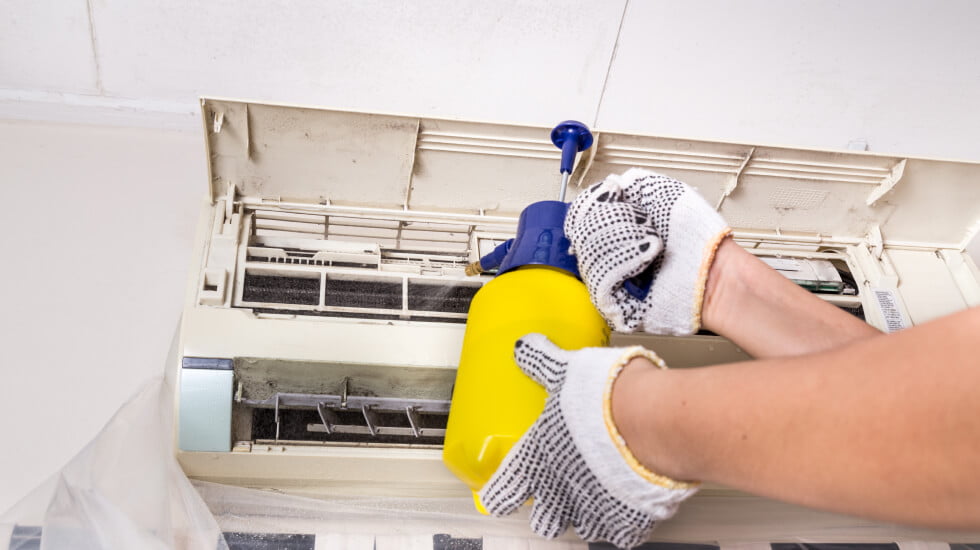
Mould-Inhibiting Technologies
Innovation in mould prevention has led to the development of advanced technologies like Panasonic’s air conditioner with nanoe™ X Generator Mark 3. This cutting-edge technology not only prevents mould growth but also purifies the air by reducing allergens and pollutants. By incorporating such advanced solutions, we can enhance the overall cleanliness and functionality of our HVAC systems, ensuring that the air we breathe remains healthy and free from contaminants.
Utilising these products and tools effectively can aid in the treatment and prevention of mould in our air conditioners. By adopting anti-mould sprays and embracing modern mould-inhibiting technologies, we can protect our HVAC systems from mould-related complications, maintain excellent indoor air quality, and secure a healthier environment for all.
In Closing
When it comes to servicing air conditioning units on the Sunshine Coast, no one does it better than our expert team at Tenmen Electrical. Give us a call today and we will help you maintain your aircon units as well as the air quality in your home.

